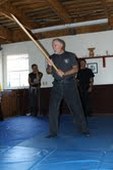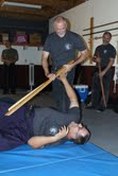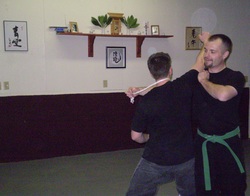Basic training information

Whats the difference between Budo Taijutsu and some other arts? Most martial arts as they exit today, do so in the form of a sport, a meditative practice, or have in some way been altered from the original practical focus that they started with. Unlike most other arts, Budo Taijutsu has been handed down for centuries without relinquishing it's combative focus. It relies on relaxed natural movement, distance and timing rather than speed or strength for it's effectiveness. This makes it ideal regarding self defense for both adults and children alike, in addition to being a preferred art for many in the law enforcement and military community.
Are weapons involved in the training? Yes. Due to the widely varied nature of the art (influences from at least nine different schools), there is quite an array of traditional, as well as modern weapons training. The basis for all weapons training, however, always returns to an understanding of the principles of unarmed movement. This is studied first and is always shown greater emphasis.
Are children s classes available? Many instructors offer children's classes within the art, however, I personally limit the age of students, generally not accepting anyone under the age of 14. This is due to sufficient attention span, combined with the highly practical nature of the art.
Other training opportunities: During the course of the year, there are a number of other instructors who come into the local area offering seminars. Most are offered by senior practitioners of the art with many years of experience. They are sometimes hosted here and sometimes at other locations, but attendance is always encouraged. This is especially the case with those who live in Japan or have frequent contact with Dr Hatsumi. Additional training opportunities can be found on the events page, and are posted with as much advanced notice as possible.
Are weapons involved in the training? Yes. Due to the widely varied nature of the art (influences from at least nine different schools), there is quite an array of traditional, as well as modern weapons training. The basis for all weapons training, however, always returns to an understanding of the principles of unarmed movement. This is studied first and is always shown greater emphasis.
Are children s classes available? Many instructors offer children's classes within the art, however, I personally limit the age of students, generally not accepting anyone under the age of 14. This is due to sufficient attention span, combined with the highly practical nature of the art.
Other training opportunities: During the course of the year, there are a number of other instructors who come into the local area offering seminars. Most are offered by senior practitioners of the art with many years of experience. They are sometimes hosted here and sometimes at other locations, but attendance is always encouraged. This is especially the case with those who live in Japan or have frequent contact with Dr Hatsumi. Additional training opportunities can be found on the events page, and are posted with as much advanced notice as possible.

Dojo etiquette: The classes begin and end with a bowing in / out process. There is no religious affiliation connected to this process. It is done as a sign of respect for, and recognition of the art and its lineage of instructors. We also bow to one another at certain times during training. This is a traditional practice and goes toward fostering the respect and good hearts needed for martial artists. Generally, tea is served immediately after training. This is a time for questions, discussions and a little social time. While relaxed, it is also an important part of the dojo and of training in general.
Be aware of your surroundings and of the people training around you. This is a combat art. You are responsible for your uke's (training partner) safety and health. Advise your training partner of any injuries you may have.
No ego. Leave it at the door. Respect and a positive attitude are a requirement for continued training. Never give up, especially on yourself.
Location: The Dojo is located east of Tucson, in Vail Arizona. Please contact by email or phone for more detailed directions. (see contact page)
Be aware of your surroundings and of the people training around you. This is a combat art. You are responsible for your uke's (training partner) safety and health. Advise your training partner of any injuries you may have.
No ego. Leave it at the door. Respect and a positive attitude are a requirement for continued training. Never give up, especially on yourself.
Location: The Dojo is located east of Tucson, in Vail Arizona. Please contact by email or phone for more detailed directions. (see contact page)

